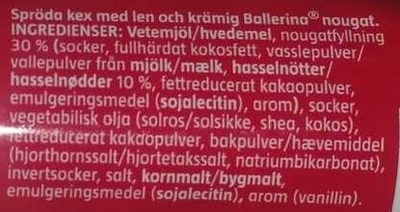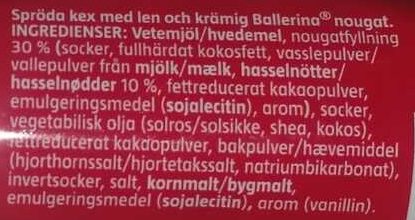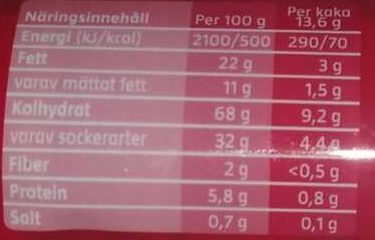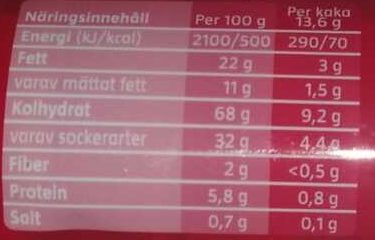Help us make food transparency the norm!
As a non-profit organization, we depend on your donations to continue informing consumers around the world about what they eat.
The food revolution starts with you!
Göteborgs Ballerina Original - 190 g e
Göteborgs Ballerina Original - 190 g e
This product page is not complete. You can help to complete it by editing it and adding more data from the photos we have, or by taking more photos using the app for Android or iPhone/iPad. Thank you!
×
Streckkod: 7310521400412 (EAN / EAN-13)
Vanligt namn: Spröda kex med len och krämig Ballerina nougat
Kvantitet: 190 g e
Förpackning: Plast
Varumärken: Göteborgs, Göteborgs Kex, Orkla Confectionery & Snacks
Kategorier: Snacks, Söta snacks, Kakor och tårtor, Kex, en:Chocolate biscuits
Länk till produktsidan på producentens officiella webbplats: http://www.goteborgskex.se/produktinfo/s...
Butiker: Coop Konsum
Matching with your preferences
Hälsa
Ingredienser
-
26 ingredienser
Vetemjöl, nougatfyllning 30 % (socker, fullhärdat kokosfett, vasslepulver från mjölk, hasselnötter 10 %, fettreducerat kakaopulver, emulgeringsmedel (sojalecitin), arom), socker, vegetabilisk olja (solros, shea, kokos), fettreducerat kakaopulver, bakpulver (hjorthornssalt, natriumbikarbonat), invertsocker, salt, kornmalt, emulgeringsmedel (sojalecitin), arom (vanillin).Allergener: Gluten, Mjölk, Nötter, Soja
Food processing
-
Ultra processed foods
Elements that indicate the product is in the 4 - Ultra bearbetade livsmedel och drycker group:
- Ingrediens: Emulgeringsmedel
- Ingrediens: Arom
- Ingrediens: Invertsocker
- Ingrediens: Vassle
Food products are classified into 4 groups according to their degree of processing:
- Obearbetade eller minimalt bearbetade livsmedel
- Bearbetade kulinariska ingredienser
- Halvfabrikat
- Ultra processed foods
The determination of the group is based on the category of the product and on the ingredients it contains.
Tillsatser
-
E500 - Natriumkarbonater
Sodium carbonate: Sodium carbonate, Na2CO3, -also known as washing soda, soda ash and soda crystals, and in the monohydrate form as crystal carbonate- is the water-soluble sodium salt of carbonic acid. It most commonly occurs as a crystalline decahydrate, which readily effloresces to form a white powder, the monohydrate. Pure sodium carbonate is a white, odorless powder that is hygroscopic -absorbs moisture from the air-. It has a strongly alkaline taste, and forms a moderately basic solution in water. Sodium carbonate is well known domestically for its everyday use as a water softener. Historically it was extracted from the ashes of plants growing in sodium-rich soils, such as vegetation from the Middle East, kelp from Scotland and seaweed from Spain. Because the ashes of these sodium-rich plants were noticeably different from ashes of timber -used to create potash-, they became known as "soda ash". It is synthetically produced in large quantities from salt -sodium chloride- and limestone by a method known as the Solvay process. The manufacture of glass is one of the most important uses of sodium carbonate. Sodium carbonate acts as a flux for silica, lowering the melting point of the mixture to something achievable without special materials. This "soda glass" is mildly water-soluble, so some calcium carbonate is added to the melt mixture to make the glass produced insoluble. This type of glass is known as soda lime glass: "soda" for the sodium carbonate and "lime" for the calcium carbonate. Soda lime glass has been the most common form of glass for centuries. Sodium carbonate is also used as a relatively strong base in various settings. For example, it is used as a pH regulator to maintain stable alkaline conditions necessary for the action of the majority of photographic film developing agents. It acts as an alkali because when dissolved in water, it dissociates into the weak acid: carbonic acid and the strong alkali: sodium hydroxide. This gives sodium carbonate in solution the ability to attack metals such as aluminium with the release of hydrogen gas.It is a common additive in swimming pools used to raise the pH which can be lowered by chlorine tablets and other additives which contain acids. In cooking, it is sometimes used in place of sodium hydroxide for lyeing, especially with German pretzels and lye rolls. These dishes are treated with a solution of an alkaline substance to change the pH of the surface of the food and improve browning. In taxidermy, sodium carbonate added to boiling water will remove flesh from the bones of animal carcasses for trophy mounting or educational display. In chemistry, it is often used as an electrolyte. Electrolytes are usually salt-based, and sodium carbonate acts as a very good conductor in the process of electrolysis. In addition, unlike chloride ions, which form chlorine gas, carbonate ions are not corrosive to the anodes. It is also used as a primary standard for acid-base titrations because it is solid and air-stable, making it easy to weigh accurately.Källa: Wikipedia (Engelska)
-
E500ii - Natriumvätekarbonat
Sodium carbonate: Sodium carbonate, Na2CO3, -also known as washing soda, soda ash and soda crystals, and in the monohydrate form as crystal carbonate- is the water-soluble sodium salt of carbonic acid. It most commonly occurs as a crystalline decahydrate, which readily effloresces to form a white powder, the monohydrate. Pure sodium carbonate is a white, odorless powder that is hygroscopic -absorbs moisture from the air-. It has a strongly alkaline taste, and forms a moderately basic solution in water. Sodium carbonate is well known domestically for its everyday use as a water softener. Historically it was extracted from the ashes of plants growing in sodium-rich soils, such as vegetation from the Middle East, kelp from Scotland and seaweed from Spain. Because the ashes of these sodium-rich plants were noticeably different from ashes of timber -used to create potash-, they became known as "soda ash". It is synthetically produced in large quantities from salt -sodium chloride- and limestone by a method known as the Solvay process. The manufacture of glass is one of the most important uses of sodium carbonate. Sodium carbonate acts as a flux for silica, lowering the melting point of the mixture to something achievable without special materials. This "soda glass" is mildly water-soluble, so some calcium carbonate is added to the melt mixture to make the glass produced insoluble. This type of glass is known as soda lime glass: "soda" for the sodium carbonate and "lime" for the calcium carbonate. Soda lime glass has been the most common form of glass for centuries. Sodium carbonate is also used as a relatively strong base in various settings. For example, it is used as a pH regulator to maintain stable alkaline conditions necessary for the action of the majority of photographic film developing agents. It acts as an alkali because when dissolved in water, it dissociates into the weak acid: carbonic acid and the strong alkali: sodium hydroxide. This gives sodium carbonate in solution the ability to attack metals such as aluminium with the release of hydrogen gas.It is a common additive in swimming pools used to raise the pH which can be lowered by chlorine tablets and other additives which contain acids. In cooking, it is sometimes used in place of sodium hydroxide for lyeing, especially with German pretzels and lye rolls. These dishes are treated with a solution of an alkaline substance to change the pH of the surface of the food and improve browning. In taxidermy, sodium carbonate added to boiling water will remove flesh from the bones of animal carcasses for trophy mounting or educational display. In chemistry, it is often used as an electrolyte. Electrolytes are usually salt-based, and sodium carbonate acts as a very good conductor in the process of electrolysis. In addition, unlike chloride ions, which form chlorine gas, carbonate ions are not corrosive to the anodes. It is also used as a primary standard for acid-base titrations because it is solid and air-stable, making it easy to weigh accurately.Källa: Wikipedia (Engelska)
-
E503 - Ammoniumkarbonater
Ammonium carbonate: Ammonium carbonate is a salt with the chemical formula -NH4-2CO3. Since it readily degrades to gaseous ammonia and carbon dioxide upon heating, it is used as a leavening agent and also as smelling salt. It is also known as baker's ammonia and was a predecessor to the more modern leavening agents baking soda and baking powder. It is a component of what was formerly known as sal volatile and salt of hartshorn.Källa: Wikipedia (Engelska)
-
E503ii - Ammoniumvätekarbonat
Ammonium carbonate: Ammonium carbonate is a salt with the chemical formula -NH4-2CO3. Since it readily degrades to gaseous ammonia and carbon dioxide upon heating, it is used as a leavening agent and also as smelling salt. It is also known as baker's ammonia and was a predecessor to the more modern leavening agents baking soda and baking powder. It is a component of what was formerly known as sal volatile and salt of hartshorn.Källa: Wikipedia (Engelska)
Ingrediensanalys
-
Palmoljefri
No ingredients containing palm oil detected
Okända ingredienser: NougatfyllningVissa ingredienser kunde inte kännas igen.
Vi behöver din hjälp!
You can help us recognize more ingredients and better analyze the list of ingredients for this product and others:
- Edit this product page to correct spelling mistakes in the ingredients list, and/or to remove ingredients in other languages and sentences that are not related to the ingredients.
- Add new entries, synonyms or translations to our multilingual lists of ingredients, ingredient processing methods, and labels.
If you would like to help, join the #ingredients channel on our Slack discussion space and/or learn about ingredients analysis on our wiki. Thank you!
-
Icke-vegan
Non-vegan ingredients: VasslepulverVissa ingredienser kunde inte kännas igen.
Vi behöver din hjälp!
You can help us recognize more ingredients and better analyze the list of ingredients for this product and others:
- Edit this product page to correct spelling mistakes in the ingredients list, and/or to remove ingredients in other languages and sentences that are not related to the ingredients.
- Add new entries, synonyms or translations to our multilingual lists of ingredients, ingredient processing methods, and labels.
If you would like to help, join the #ingredients channel on our Slack discussion space and/or learn about ingredients analysis on our wiki. Thank you!
-
Vegetarisk status okänd
Okända ingredienser: Nougatfyllning, Invertsocker, VanillinVissa ingredienser kunde inte kännas igen.
Vi behöver din hjälp!
You can help us recognize more ingredients and better analyze the list of ingredients for this product and others:
- Edit this product page to correct spelling mistakes in the ingredients list, and/or to remove ingredients in other languages and sentences that are not related to the ingredients.
- Add new entries, synonyms or translations to our multilingual lists of ingredients, ingredient processing methods, and labels.
If you would like to help, join the #ingredients channel on our Slack discussion space and/or learn about ingredients analysis on our wiki. Thank you!
-
Details of the analysis of the ingredients
Vi behöver din hjälp!
Vissa ingredienser kunde inte kännas igen.
Vi behöver din hjälp!
You can help us recognize more ingredients and better analyze the list of ingredients for this product and others:
- Edit this product page to correct spelling mistakes in the ingredients list, and/or to remove ingredients in other languages and sentences that are not related to the ingredients.
- Add new entries, synonyms or translations to our multilingual lists of ingredients, ingredient processing methods, and labels.
If you would like to help, join the #ingredients channel on our Slack discussion space and/or learn about ingredients analysis on our wiki. Thank you!
: _Vetemjöl_, nougatfyllning 30% (socker, fullhärdat kokosfett, vasslepulver från _mjölk_, _hasselnötter_ 10%, fettreducerat kakaopulver, emulgeringsmedel (_sojalecitin_), arom), socker, vegetabilisk olja (solros, shea, kokos), fettreducerat kakaopulver, bakpulver (hjorthornssalt, natriumbikarbonat), invertsocker, salt, _kornmalt_, emulgeringsmedel (_sojalecitin_), arom (vanillin)- _Vetemjöl_ -> en:wheat-flour - vegan: yes - vegetarian: yes - ciqual_proxy_food_code: 9410
- nougatfyllning -> sv:nougatfyllning - percent: 30
- socker -> en:sugar - vegan: yes - vegetarian: yes - ciqual_proxy_food_code: 31016
- fullhärdat kokosfett -> en:fully-hydrogenated-coconut-fat - vegan: yes - vegetarian: yes - from_palm_oil: no - ciqual_food_code: 16040
- vasslepulver från _mjölk_ -> en:whey-powder - vegan: no - vegetarian: maybe
- _hasselnötter_ -> en:hazelnut - vegan: yes - vegetarian: yes - ciqual_food_code: 15004 - percent: 10
- fettreducerat kakaopulver -> en:fat-reduced-cocoa-powder - vegan: yes - vegetarian: yes - ciqual_food_code: 18100
- emulgeringsmedel -> en:emulsifier
- _sojalecitin_ -> en:soya-lecithin - vegan: yes - vegetarian: yes - ciqual_food_code: 42200
- arom -> en:flavouring - vegan: maybe - vegetarian: maybe
- socker -> en:sugar - vegan: yes - vegetarian: yes - ciqual_proxy_food_code: 31016
- vegetabilisk olja -> en:vegetable-oil - vegan: yes - vegetarian: yes - from_palm_oil: maybe
- solros -> en:sunflower - vegan: yes - vegetarian: yes
- shea -> en:shea-butter - vegan: yes - vegetarian: yes - from_palm_oil: no
- kokos -> en:coconut - vegan: yes - vegetarian: yes - ciqual_proxy_food_code: 15006
- fettreducerat kakaopulver -> en:fat-reduced-cocoa-powder - vegan: yes - vegetarian: yes - ciqual_food_code: 18100
- bakpulver -> en:baking-powder - vegan: yes - vegetarian: yes - ciqual_food_code: 11046
- hjorthornssalt -> en:e503ii - vegan: yes - vegetarian: yes
- natriumbikarbonat -> en:e500ii - vegan: yes - vegetarian: yes
- invertsocker -> en:invert-sugar
- salt -> en:salt - vegan: yes - vegetarian: yes - ciqual_food_code: 11058
- _kornmalt_ -> en:malted-barley - vegan: yes - vegetarian: yes
- emulgeringsmedel -> en:emulsifier
- _sojalecitin_ -> en:soya-lecithin - vegan: yes - vegetarian: yes - ciqual_food_code: 42200
- arom -> en:flavouring - vegan: maybe - vegetarian: maybe
- vanillin -> en:vanillin
Näring
-
Bad nutritional quality
⚠ ️Warning: the amount of fruits, vegetables and nuts is not specified on the label, it was estimated from the list of ingredients: 11This product is not considered a beverage for the calculation of the Nutri-Score.
Positiva poäng: 2
- Proteiner: 3 / 5 (värde: 5.8, avrundat värde: 5.8)
- Fiber: 2 / 5 (värde: 2, avrundat värde: 2)
- Frukt, grönsaker, nötter och raps- / valnöt- / olivoljor: 0 / 5 (värde: 11.25, avrundat värde: 11.3)
Negativa poäng: 26
- Energi: 6 / 10 (värde: 2100, avrundat värde: 2100)
- Socker: 7 / 10 (värde: 32, avrundat värde: 32)
- Mättat fett: 10 / 10 (värde: 11, avrundat värde: 11)
- Natrium: 3 / 10 (värde: 280, avrundat värde: 280)
The points for proteins are not counted because the negative points are greater or equal to 11.
Näringsvärde: (26 - 2)
Nutri-Score:
-
Näringsvärden
-
Fett i hög kvantitet (22%)
What you need to know- A high consumption of fat, especially saturated fats, can raise cholesterol, which increases the risk of heart diseases.
Recommendation: Limit the consumption of fat and saturated fat- Choose products with lower fat and saturated fat content.
-
Mättat fett i hög kvantitet (11%)
What you need to know- A high consumption of fat, especially saturated fats, can raise cholesterol, which increases the risk of heart diseases.
Recommendation: Limit the consumption of fat and saturated fat- Choose products with lower fat and saturated fat content.
-
Sockerarter i hög kvantitet (32%)
What you need to know- A high consumption of sugar can cause weight gain and tooth decay. It also augments the risk of type 2 diabetes and cardio-vascular diseases.
Recommendation: Limit the consumption of sugar and sugary drinks- Sugary drinks (such as sodas, fruit beverages, and fruit juices and nectars) should be limited as much as possible (no more than 1 glass a day).
- Choose products with lower sugar content and reduce the consumption of products with added sugars.
-
Salt i måttlig kvantitet (0.7%)
What you need to know- A high consumption of salt (or sodium) can cause raised blood pressure, which can increase the risk of heart disease and stroke.
- Many people who have high blood pressure do not know it, as there are often no symptoms.
- Most people consume too much salt (on average 9 to 12 grams per day), around twice the recommended maximum level of intake.
Recommendation: Limit the consumption of salt and salted food- Reduce the quantity of salt used when cooking, and don't salt again at the table.
- Limit the consumption of salty snacks and choose products with lower salt content.
-
-
Näringsfakta
Näringsfakta Som såld
för 100 g / 100 mlSom såld
per portion (13,6 g)Compared to: en:Chocolate biscuits Energi 2 100 kj
(502 kcal)286 kj
(68 kcal)- Fett 22 g 2,99 g −11 % Mättat fett 11 g 1,5 g −14 % Kolhydrat 68 g 9,25 g +11 % Sockerarter 32 g 4,35 g −13 % Fiber 2 g 0,272 g −42 % Protein 5,8 g 0,789 g −3 % Salt 0,7 g 0,095 g +13 % Fruits‚ vegetables‚ nuts and rapeseed‚ walnut and olive oils (estimate from ingredients list analysis) 11,25 % 11,25 %
Miljö
-
Eco-Score C - Måttlig miljöpåverkan
The Eco-Score is an experimental score that summarizes the environmental impacts of food products.→ The Eco-Score was initially developped for France and it is being extended to other European countries. The Eco-Score formula is subject to change as it is regularly improved to make it more precise and better suited to each country.Life cycle analysis
-
Average impact of products of the same category: C (Score: 56/100)
Kategori: Biscuit (cookie), with chocolate, prepacked
Kategori: Biscuit (cookie), with chocolate, prepacked
- PEF environmental score: 0.47 (the lower the score, the lower the impact)
- including impact on climate change: 5.92 kg CO2 eq/kg of product
Stage Impact Jordbruk
63.6 %Bearbetar
29.8 %Förpackning
2.3 %Transportation
3.2 %Distribution
1.0 %Consumption
0.0 %
Bonuses and maluses
-
Missing origins of ingredients information
Malus: -5
⚠ ️ The origins of the ingredients of this product are not indicated.
If they are indicated on the packaging, you can modify the product sheet and add them.
If you are the manufacturer of this product, you can send us the information with our free platform for producers.
-
Packaging with a medium impact
Malus: -10
Form Material Återvinning Impact Okänd Plast Hög ⚠ ️ The information about the packaging of this product is not sufficiently precise (exact shapes and materials of all components of the packaging).⚠ ️ For a more precise calculation of the Eco-Score, you can modify the product page and add them.
If you are the manufacturer of this product, you can send us the information with our free platform for producers.
Eco-Score for this product
-
Impact for this product: C (Score: 41/100)
Produkt: Göteborgs Ballerina Original - 190 g e
Life cycle analysis score: 56
Sum of bonuses and maluses: -15
Final score: 41/100
-
Carbon footprint
-
Equal to driving 3.1 km in a petrol car
592 g CO² per 100g of product
The carbon emission figure comes from ADEME's Agribalyse database, for the category: Biscuit (cookie), with chocolate, prepacked (Source: ADEME Agribalyse Database)
Stage Impact Jordbruk
52.9 %Bearbetar
42.0 %Förpackning
1.9 %Transportation
2.9 %Distribution
0.3 %Consumption
0.0 %
Förpackning
-
Packaging with a medium impact
-
Packaging parts
(Plast)
-
Packaging materials
Material % Packaging weight Packaging weight per 100 g of product Plast
-
Transportation
-
Origins of ingredients
Missing origins of ingredients information
⚠ ️ The origins of the ingredients of this product are not indicated.
If they are indicated on the packaging, you can modify the product sheet and add them.
If you are the manufacturer of this product, you can send us the information with our free platform for producers.Add the origins of ingredients for this product Add the origins of ingredients for this product
Report a problem
-
Incomplete or incorrect information?
Category, labels, ingredients, allergens, nutritional information, photos etc.
If the information does not match the information on the packaging, please complete or correct it. Open Food Facts is a collaborative database, and every contribution is useful for all.
Datakällor
Produkt tillagd den av openfoodfacts-contributors
Senast ändrad produktsida på av packbot.
Produktsida också redigerad av akitainu, beniben, kiliweb, olofolleola4, yuka.UTc0REtwd1BxdjhseHNFOTF5Nzg1dGwvKzU3MGMwS1lPK2cxSVE9PQ.










